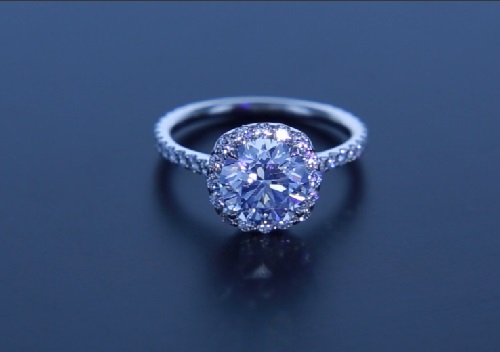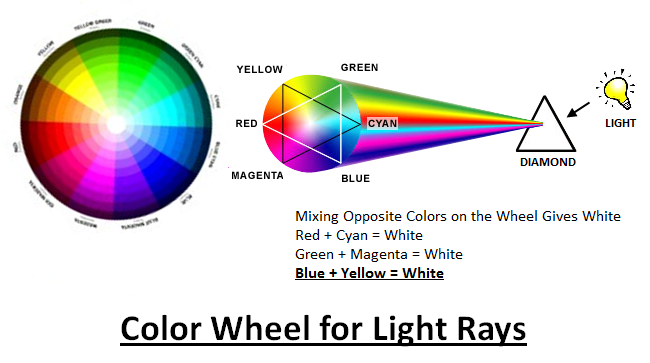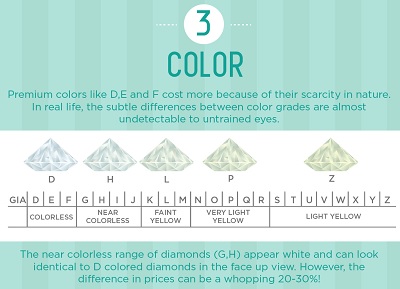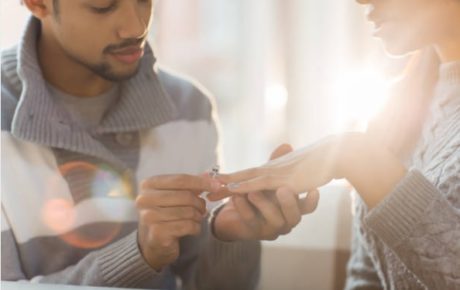Shouldn’t Blue Fluorescence Make Yellow Diamonds Green?

Halo diamond ring exhibiting fluorescence in UV lighting – Brian Gavin
A reader emailed us the following question: “Since young, we were taught in art classes that Blue + Yellow = Green when we mix colors. Is there a mistake you made on your website when you mentioned that blue fluorescence actually helps make a yellow diamond white?
Instead, shouldn’t it be making the stone look green instead? Even my local jeweler is telling me the same thing that having medium blue fluorescence in a H colored stone will actually help improve its color.
Did you make an error on your site and that the local jeweler is wrong? I would love to hear from you about what you think.”
This was an interesting question posted to us by Natalie B and I happen to have some background knowledge on this topic. Back in my university days of attending a physics lecture on light waves and colors, I learnt that the vision our eyes see can actually be broken down into 2 forms.
Pigmentation And Light in Diamonds

Based on the chart, shouldn’t blue fluorescence make yellow diamonds green?
The above diagram is what we use in pigmentation. This is commonly used as a reference for mixing paints or watercolors during art classes. The primary colors (Yellow, Blue And Red) are found in the middle of the diagram. We get our secondary colors by mixing any 2 primary colors.
Technically speaking, we call this subtractive mixing.
On the other hand, this wheel isn’t applicable when we are talking about light rays passing through a diamond. Instead, the technical name when it comes to combining light rays is called additive mixing.

Here’s a quick layman analogy to what happens in the case of viewing a diamond. If a diamond has blue fluorescence, the light rays passing through the stone turns blue in the presence of ultraviolet environments.
If you couple this with a slightly yellow tinted diamond (J-K), this means we now have a mixture of yellow and blue light rays. The end effect results in a white colored light ray being reflected back into our eyes. We thus perceive the gemstone to look whiter than it actually is.
Hope this explanation helps to clear up the queries. And blue fluorescence does help makes a diamond whiter in UV lighting environments.
Paul
If you are looking for top quality round brilliant cuts with blue fluorescence, check out Brian Gavin’s Blue signature diamonds. Each individual stone has to pass through a series of inspections by Brian Gavin and is guaranteed to meet with the high standards before being listed.
Related Articles
Leave A Comment












4 Comments
Great information and diagrams. That’s a super clear article to explain a similar query I had. It brings back fond memories of art classes during childhood as well.
do you have any idea where I can buy “blue white” diamonds?
I haven’t heard anyone use that term in recent times. It’s a really old school term use to define diamonds graded with a D color and very strong blue fluorescence. Nowadays, nobody uses the term anymore as it is a misleading and violates regulations.
If you are looking for ideal cut diamonds with strong fluorescence, try Brian Gavin’s Blue Signature Diamonds. You might be interested to read our review of that here: https://beyond4cs.com/reviews/brian-gavin-diamonds/blue/
An ethical jeweler will sell you a fluorescent diamond for up to 50 percent less on strong blue diamonds because they are worth that much less and the jeweler paid that much less. If you like, buy but know you can pay a lot less. Know the facts. Diamonds are awesome. Do your homework.